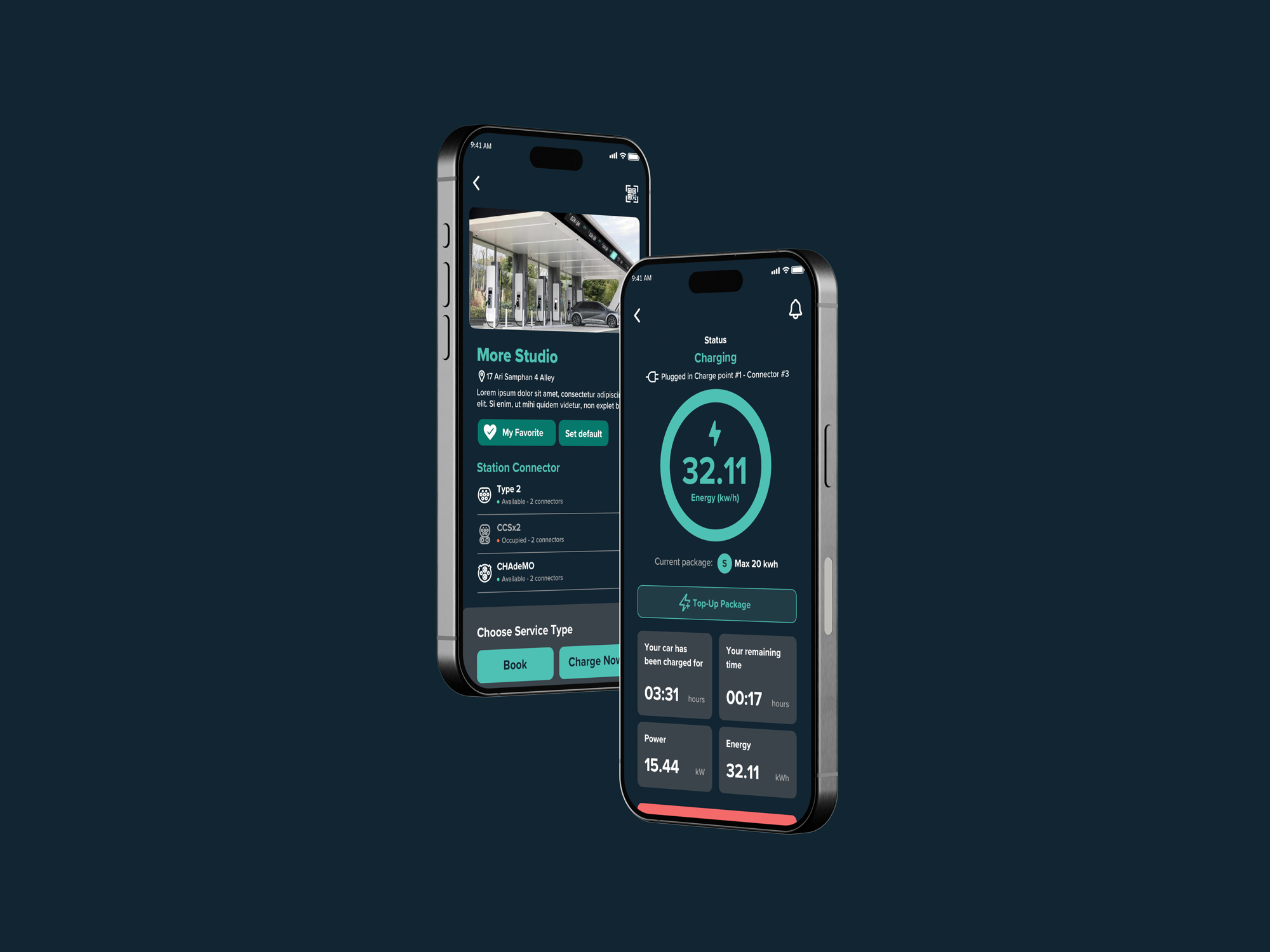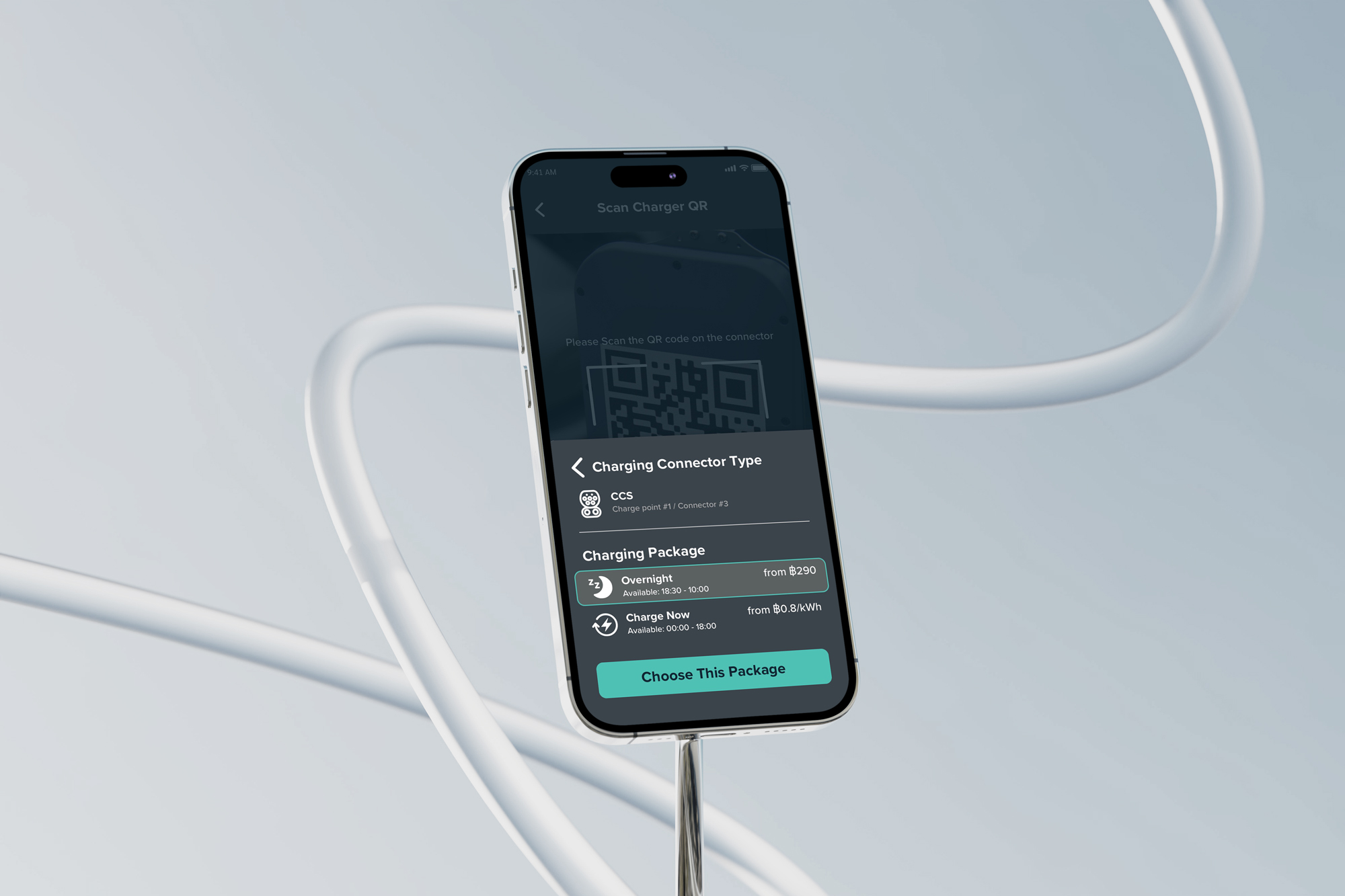
Zleep Charge
Mobile Application design and Development for Zleep Charge
Zleep Charge is an EV charging service provider in Thailand, designed to offer a seamless charging experience for electric vehicle owners. The company is part of the broader expansion of EV infrastructure in Thailand, which has seen significant growth due to government initiatives and the increasing popularity of electric vehicles in the region.
Project Overview
Zleep Charge aimed to provide a unique and seamless EV charging experience in Thailand by introducing features that allow users to book and charge their vehicles overnight. Partnering with Lumpini Condo, a leading residential developer, Zleep Charge sought to integrate convenient charging solutions within residential spaces, offering unmatched accessibility to EV owners.
The project involved the creation of a development of a mobile application that would cater to the needs of modern EV users. The branding was designed to resonate with the concept of a worry-free, overnight charging experience, while the app was tailored to provide detailed and user-friendly controls.

Understand the problem
Problem Statement
Many EV owners living in condos face the inconvenience of managing their vehicle’s charging, especially during the night. Traditional charging methods require users to stay awake or set alarms to ensure their car doesn’t overcharge, leading to disrupted sleep and a frustrating experience. This is particularly challenging for residents of large condos, where shared resources like charging stations are often in high demand.
Here come the "Overnight" features
Zleep Charge’s innovative Overnight Charge feature offers a solution by allowing users to select a charging package that aligns with their needs—be it short or extended charging periods. This feature enables users to plug in their vehicles, go to sleep, and trust that their car will be charged appropriately, without the need to monitor or manually stop the charging process.

①
Convenience through Booking
Zleep Charge allows users to book their charging sessions in advance, ensuring they have a dedicated spot waiting for them. This eliminates the uncertainty of finding an available charger, making the process more predictable and stress-free.
②
Overnight Charging for Hassle-Free Experience
The overnight charging feature lets users charge their vehicles while they sleep, taking advantage of off-peak hours. This not only ensures their vehicle is fully charged by morning but also maximizes the efficiency of their time. Users can wake up to a fully charged car without having to worry about the duration or availability of chargers during the day.
③
Consistency and Reliability
With Zleep Charge’s integrated system, users are provided with clear, consistent information on the charging process, including duration and status updates. This reliability and transparency reduce anxiety and inspire confidence in the charging process.
Iterative Design: A Path of Continuous Learning
Design Mobile Application process
☞ Prototyping

☞ User Flow & User Journeys

Booking Flow: Design Principle
The flow design of the Zleep Charge app is built with simplicity in mind, making the entire booking process as easy and smooth as possible. The steps are laid out clearly, so even if you aren’t tech-savvy, you can navigate through the app without any issues. It all starts with selecting your charging station, then you choose a date through an intuitive calendar. What’s great is that the app gives you real-time updates, like checking if a station is already booked, which helps you avoid any confusion or double bookings.

Key info is front and center throughout the process. For instance, right after you pick your date, the app shows you tailored charging package options, making it easy to choose what suits you best. The payment process is integrated seamlessly, so you don’t get stuck in long, complicated transaction steps. By focusing on clear, simple steps, Zleep Charge reduces the effort needed to complete a booking, making the experience enjoyable and frustration-free. This user-friendly approach not only makes the app easier to use but also keeps customers happy and coming back
☞ Symbol & Style guide

technical implementation
Development and Integration
Parallel to our design refinements, our development team began the technical implementation. This phase involved translating our high-fidelity designs into a working mobile application. Our developers and designers worked closely, ensuring that the technology we used was both robust and capable of supporting the unique needs of rural communities, such as low bandwidth environments and various mobile device capabilities.
☞ Project Challenges

Challenges
The development of Zleep Charge posed significant hurdles, particularly because the Morestudio team lacked specialized expertise in integrating software with hardware. This forced the team to engage in extensive Research and Development (R&D) to navigate these challenges. One of the primary obstacles was adapting to the early-stage Open Charge Point Protocol (OCPP), which lacked standardization across different EV chargers. Each charger complied with the protocol differently, requiring the team to conduct time-consuming testing and system reconfigurations. Furthermore, the system needed to support real-time updates between the chargers and the app, which added another layer of complexity. The limited availability of test vehicles further complicated the process, slowing down testing and system integration.
How we overcome it
Despite these difficulties, the Morestudio team managed to find effective solutions through rigorous R&D. By developing a robust software architecture and integrating cloud-based technologies, they were able to streamline communication between the charging stations and the app. This allowed for smoother updates and ensured the system could handle future expansions. Through their perseverance, the team ensured that Zleep Charge delivered a seamless charging experience. We continue to develop Zleep Charge and explore new technologies to ensure our customers always receive the best possible experience.
① Challenges
The development of Zleep Charge posed significant hurdles, particularly because the Morestudio team lacked specialized expertise in integrating software with hardware. This forced the team to engage in extensive Research and Development (R&D) to navigate these challenges. One of the primary obstacles was adapting to the early-stage Open Charge Point Protocol (OCPP), which lacked standardization across different EV chargers. Each charger complied with the protocol differently, requiring the team to conduct time-consuming testing and system reconfigurations. Furthermore, the system needed to support real-time updates between the chargers and the app, which added another layer of complexity. The limited availability of test vehicles further complicated the process, slowing down testing and system integration.
② How we overcome it
Despite these difficulties, the Morestudio team managed to find effective solutions through rigorous R&D. By developing a robust software architecture and integrating cloud-based technologies, they were able to streamline communication between the charging stations and the app. This allowed for smoother updates and ensured the system could handle future expansions. Through their perseverance, the team ensured that Zleep Charge delivered a seamless charging experience.
We continue to develop Zleep Charge and explore new technologies to ensure our customers always receive the best possible experience.
☞ Dynamic Design and Customer Empowerment through CMS

In designing Zleep Charge, the goal was to create a highly dynamic system that could adapt to the varying needs of customers. A key component of this design is the Content Management System (CMS), which empowers the client to resolve many initial issues independently. This level of flexibility ensures that Zleep Charge can provide excellent customer support, allowing users to manage and troubleshoot minor issues without needing direct intervention from the technical team. The CMS streamlines operations, enabling quicker updates and smoother service, which ultimately enhances the overall user experience and reliability of the system.



